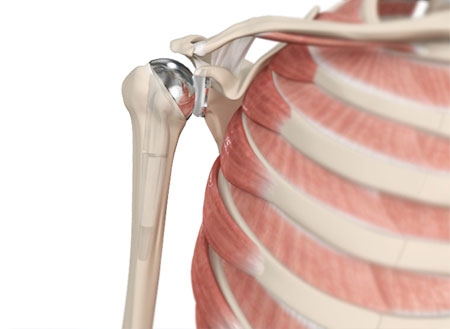Advancements in the realm of shoulder replacement render it an excellent surgical intervention for shoulder pathologies such as arthritis, rotator cuff tearing, or fracture. However, shoulder replacement is still lesser known compared to the seemingly more common hip and knee replacements.
The shoulder is a complex joint because it is of the ‘ball and socket’ variety – yet the socket is very shallow (unlike the hip), meaning that it moves and functions in a myriad of different directions rather than, say, a knee that primarily moves forwards and backwards. The shoulder joint is composed of the upper arm (or humerus bone), the clavicle (or collarbone), and the scapula (or shoulder blade). These bony structures are accompanied by the rotator cuff, which is composed of four different muscles. These muscles work together to provide stability to the shoulder while still allowing it to move multi-directionally. The unique aspect of a shoulder replacement is that two different types of replacements exist: an anatomic total shoulder replacement and a reverse total shoulder replacement.
An anatomic shoulder replacement is most commonly performed when the joint is arthritic and causing the patient significant pain and dysfunction. The procedure involves cutting off the arthritic end of the humerus, and placing an artificial head, and then placing a new plastic component on the arthritic socket of the joint. The artificial parts restore smooth, pain-free motion. Because this implant maintains the anatomy of the joint, a healthy rotator cuff is necessary for stability and function.
If the integrity of the rotator cuff is compromised, a reverse shoulder replacement is utilized instead. This implant eliminates the need for the rotator cuff by reversing the anatomy, as the name implies. The arthritic head of the humerus is still removed, and a stem is still inserted into the canal of the bone. However, the ball of the joint is then placed on the socket side and a new socket is placed on the stem side. This device is powered by the deltoid muscle, which is a large muscle on the outside aspect of the shoulder. The deltoid can compensate for a deficient rotator cuff to provide shoulder motion and function, due to the altered mechanics offered by the reverse device. This procedure is performed to improve pain and mobility, not to restore strength as the rotator cuff is not repaired.
It should be noted that other factors often play a role in determining which implant would best serve a patient such as age, activity level, general health, and surgical history on the shoulder.
Because of the differing mechanics of these implants, the risk profile for each implant is different as well. The biggest post-operative risks with an anatomic replacement are loosening of the glenoid (or socket component) and rotator cuff failure. If either of these instances occur and the patient cannot tolerate their symptoms, a revision procedure is considered. The surgery would entail changing out the modular components to convert the implant to a reverse replacement.
Alternatively, the risks with a reverse replacement include scapular spine stress fracture and instability. A stress fracture can occur when the body doesn’t adjust to the new stresses caused by the reversed anatomy of the implant. This stress can crack the acromion, or superior portion of the scapula. Most often, this is treated conservatively with rest. However, if the fracture doesn’t heal and pain persists, surgical intervention to fixate the fracture may be recommended. This risk is highest in older women with compromised bone density. Instability, on the other hand, is more common in men. Instability (or the implants coming out of alignment/dislocation) typically occurs in men early in the recovery process. If the components are only ‘perching’ (or threatening to dislocate rather than frankly dislocating), relative rest followed by therapeutic exercise to strengthen the deltoid can alleviate the problem. If instability persists or the implant frankly dislocates, revision surgery is typically warranted.
Shoulder replacement, regardless of the implant, is an elective procedure performed when a patient decides their shoulder pain and dysfunction prevents them from living the life they want to live. This surgery is an excellent option for alleviating pain and restoring function.




